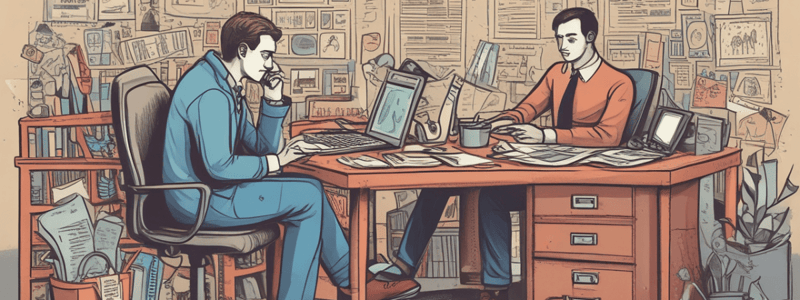Podcast
Questions and Answers
What is full employment?
What is full employment?
- A situation where everyone who wants a job can find one at existing wage levels (correct)
- A situation where unemployment rate is 0%
- A situation where everyone is unemployed
- A situation where everyone has a job, regardless of wage levels
What is the workforce?
What is the workforce?
- All those who are employed (correct)
- All those who are unemployed
- All those who are employed and unemployed
- All those who are available for work and actively seeking work
What is underemployment?
What is underemployment?
- When a worker is not working at all
- When a worker is working part-time
- When a worker's skills/time are not being utilised to their full potential (correct)
- When a worker's skills/time are being utilised to their full potential
What is the labour force?
What is the labour force?
What is unemployment?
What is unemployment?
What is the unemployment rate?
What is the unemployment rate?
What type of unemployment occurs when jobs become obsolete due to technological advancements?
What type of unemployment occurs when jobs become obsolete due to technological advancements?
Which type of unemployment affects individuals who have recently entered the labour force or are transitioning between jobs?
Which type of unemployment affects individuals who have recently entered the labour force or are transitioning between jobs?
What type of unemployment is experienced by workers in industries with seasonal fluctuations in demand?
What type of unemployment is experienced by workers in industries with seasonal fluctuations in demand?
Which type of unemployment is caused by a decrease in aggregate demand during an economic downturn?
Which type of unemployment is caused by a decrease in aggregate demand during an economic downturn?
What is a common characteristic of both frictional and structural unemployment?
What is a common characteristic of both frictional and structural unemployment?
Flashcards
Full Employment
Full Employment
Situation where almost everyone who wants a job can find one at existing wage levels. Typically around 4% unemployment.
Employment
Employment
Refers to individuals currently engaged in work in return for payment.
Unemployment
Unemployment
Individuals not working but available and actively seeking work.
Workforce
Workforce
Signup and view all the flashcards
Labour Force
Labour Force
Signup and view all the flashcards
Unemployment Rate
Unemployment Rate
Signup and view all the flashcards
Underemployment
Underemployment
Signup and view all the flashcards
Structural Unemployment
Structural Unemployment
Signup and view all the flashcards
Frictional Unemployment
Frictional Unemployment
Signup and view all the flashcards
Seasonal Unemployment
Seasonal Unemployment
Signup and view all the flashcards
Cyclical Unemployment
Cyclical Unemployment
Signup and view all the flashcards
Study Notes
Employment and Unemployment
- Full Employment: A situation where everyone who wants a job can find one at existing wage levels, usually indicated by an unemployment rate of 4%.
- Zero Unemployment: Unachievable in reality due to structural and frictional unemployment.
Key Concepts
- Employment: Refers to individuals currently engaged in work in return for payment.
- Unemployment: Refers to individuals who are not working but are available for work and actively seeking work.
- Workforce: All those who are employed.
- Labour Force: All those who are available for work and are actively seeking work or engaged in work currently (includes both workforce and unemployed individuals).
- Unemployment Rate: The proportion of the labour force that is currently unemployed.
Additional Concepts
- Underemployment: Occurs when a worker's skills/time are not being utilized to their full potential, e.g., a highly qualified family member returning home to work on the family farm.
Causes of Unemployment
- Structural Unemployment: arises from a mismatch between the skills of the unemployed and available job openings, often due to technological advancements rendering certain jobs obsolete, such as checkout operators being replaced by self-service tills.
Types of Unemployment
- Frictional Unemployment: occurs when individuals are transitioning between jobs, entering the labor force for the first time, or seeking new employment opportunities after leaving a previous job.
Seasonal Unemployment
- Temporary unemployment experienced by individuals working in industries with seasonal fluctuations, such as tourism, resulting in job losses during off-peak seasons, e.g., tour guides or hotel receptionists during winter months.
Cyclical Unemployment
- Unemployment resulting from decreased demand for goods and services during economic downturns, such as the 2008 financial crisis in Ireland or the 2020 Covid-19 pandemic, leading to increased job losses.
Studying That Suits You
Use AI to generate personalized quizzes and flashcards to suit your learning preferences.



